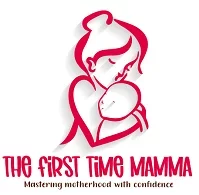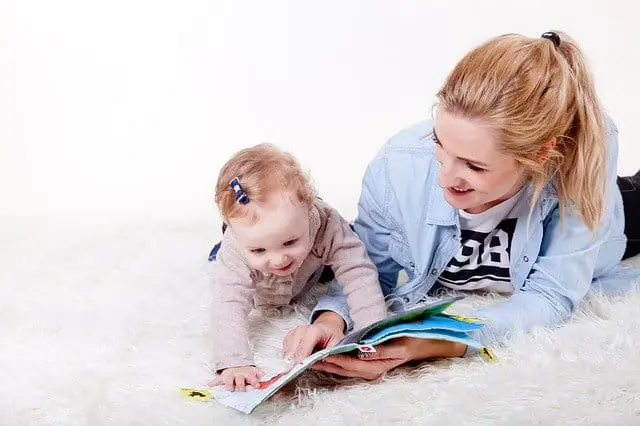The idea of baby talking may seem implausible, but language acquisition and development starts early. As soon as a baby is born, their learning process begins. By reading your baby’s cues or their facial expression you can learn and respond to their basic needs accordingly in the early stages, but when babies reach 6 to 12 months of age their learning process develops rapidly. This is the perfect time to interact with your little one in ways that are meaningful and encourage their budding communication skills.
Hey! By the way… any links on this page that lead to products on Amazon are affiliate links and I earn a commission if you make a purchase. Thanks in advance – I really appreciate it! .
There are a variety of conversational topics for a baby. It can range from what you and your baby are doing and feeling all the way to how their senses perceive their surroundings. Here is a list of some fun and quick language building activities for 6 to 12 months old baby.
1). Ask them questions related to their surroundings and what they are sensing
The first language building activities you can start with your baby is to ask them questions. For example, you can ask them a question, like, ‘what are you hearing?’ They won’t respond to the question in the beginning. So, you can try supplementing the answer for them like, ‘the birds are chirping outside.’ As baby begins to respond to your queries with coos, babbles and eventually with words, stop for some time for their response and when they do respond react enthusiastically and expand on it. E.g. if they respond to the previous question as ‘birdy!’ you can say, ‘yes, the birds are chirping!’ this way, you used the word they said and added more language to model a short phrase.
2). Copy your baby’s coos and babbles
This will encourage them to copy your words and help them learn new words and how they are used in everyday life.
3) Describe what the baby is doing to them
Babies like touching things. For example, if your baby is nuzzling your shirt to tell you they are hungry and need to feed, you can describe it like, ‘ooh, you are nuzzling my shirt? Is my little munchkin hungry? Your yummy milk is coming right up!’ Although they won’t understand your words right away but your loving and caring tone followed by action will make them feel you understand them and as time goes by, your baby will understand the meaning of these words.
4) Sing songs to them or make up your own songs
Babies love hearing your voice. So you don’t have to worry about being off-key or your voice not sounding good. They will like it, regardless of your off-key tune.
5) Reading baby books helps a lot
Get a good book and read it to them. Reading with their favorite person in the world i.e. You will make them develop a love for reading books and reading aloud also enhances their vocabulary and provides them with the chance to listen to new words and learn their meaning.
6) Read with power!
Describe the scenes in different tones for different characters in the book. Babies love it when adults make silly noises, and it also makes reading time more fun for you and your baby.
7) Follow your baby’s cues during reading time
If they want to look at only one picture or want to flip pages quickly, then let them do it. This will make reading a positive experience for the baby, and they may even start developing a good habit of reading a storybook before bed.
8) Make a photo album of your baby
Glue their pictures in a book with the family members and leave some space to write something about everyone. Your baby will love seeing pictures of their favorite people and hearing you talk about them.
9) Sing songs to them with actions
The perfect song for this purpose would be, “if you’re happy and you know it clap your hand.” Your voice followed by action will teach them different skills, what they mean and when to use it.
10) Around the baby’s first birthday, show them how to complete a puzzle.
Show and tell them first how it works by guiding their hands and cheer and clap for them when their puzzle pieces fit perfectly.
11) Fill an empty plastic bottle with rice, wheat or other grains and shake it to make a sound.
A bottle rarely makes this noise, so hearing these new and fresh noises will be an element of surprise for the baby. This will teach them about the cause and effect phenomenon. For example, shaking the bottles makes noises because it is filled with grains of rice.
12) In enhancing your baby’s vocabulary, more is better
The more words that your baby hears daily, the more they will learn, absorb and eventually put to use themselves. Try to use a range of striking words in daily conversation. For example, when recounting a fabric pattern, try using words such as unusual, relaxing, or creative. These words may be beyond a baby’s understanding but by using them in the proper context you’ll make them more comprehensible.
13) Show your baby flashcards and books with pictures of animals or body parts with their names written below
Read and show them the picture and explain what it is. By 12 months, your baby will be able to point to the correct picture when you show them more than once and ask “which one is the dog?”
These language building activities will help you in building your baby’s conversational skills, and what’s most important about these activities is having fun together. In this way, while you both are having fun, your baby is learning new words and skills every day. Keep in mind that every baby is different, what works for others may not work for you. So, it is a process of trial and error. Don’t compare your baby’s skills with other babies, this will only make you worried. Your baby will learn at his/her own pace. So, enjoy and cherish these moments because they are very short-lived.

